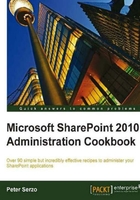
SharePoint 2010 enables businesses to set up collaboration with, and for, many types of entities (employees, vendors, customers, and so on) while integrating disparate technologies. It has proved so valuable a tool at many organizations that its growth has led it to become a mission-critical application. As SharePoint has grown through each version, it has assimilated several technologies. It now encompasses technologies such as content management, Microsoft Access, and Visio to name a few.
The administrator's challenge with SharePoint 2010 is recognizing where to perform vital tasks in a product that is as vast as it is deep. The recipes here represent common tasks that an administrator must be knowledgeable about. These are foundational tasks that, in most cases, can be combined and built upon. Features are titled so that even if the task is performed sporadically, you can look at the title and use the book as a reference guide. It is my hope that the book becomes a resource that is referenced often.
Chapter 1, Upgrading and Configuring SharePoint 2010, contains recipes that deal with configuring and getting SharePoint up and going. These recipes not only cover upgrading from a previous version but also contain explanations on how to create new web applications and associated components.
Chapter 2, Service Applications, covers recipes involving service applications, which is a new concept to SharePoint 2010. These recipes cover the main service applications such as managed metadata and Excel. It also covers the components of a service application, such as custom groups, that can be configured.
Chapter 3, Farm Governance, covers different items that relate to managing SharePoint 2010. These recipes will be implemented based on guidance from your organization. The recipes support the rules that govern your organization, such as how to restrict web parts or setting up a managed account.
Chapter 4, Site Administration, contains key recipes for managing the site-level components. Error pages, content types, retention policies, and records management are some of the topics that are covered.
Chapter 5, Monitoring and Reporting, covers recipes involving the different tools in SharePoint 2010 that assist the administrator in managing SharePoint. These tools are critical to knowing how the SharePoint 2010 installation operates. The recipes show how to manage the tools.
Chapter 6, Search, covers the core components within SharePoint 2010. The topics here range from how to scale out the Search components to customizing search. Search is a broad foundational topic in SharePoint and the recipes here provide a granular view into what an administrator can do.
Chapter 7, Security Administration: Users and Groups, contains recipes related to user access. The list of topics range from site collection-level access to site-level access.
Chapter 8, Content Management, is about different aspects of SharePoint 2010. These recipes range from term sets, setting up a content type hub, routing documents, to managing external content types.
Chapter 9, Social Architecture, is a new topic for SharePoint 2010. The features covered in the recipes have to do with setting up a tag cloud managing the social features for a user. The recipes give the administrator a broad range of where and how the social environment can be managed in SharePoint.
Chapter 10, Backup and Restore, is a topic that should be familiar to all administrators. The recipes here cover everything from the recycle bin to a farm backup and restore.
Chapter 11, Performance Monitoring, covers some lesser-known ways to monitor SharePoint. The recipes here introduce tools, some of which are not native to SharePoint, but the functionalities they provide assist the administrator without requiring a financial investment. The recipes show how to use these readily available tools.